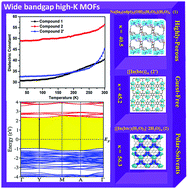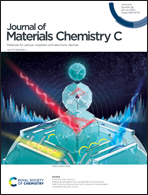Thermally stable indium based metal–organic frameworks with high dielectric permittivity†
Abstract
The self-assembly of two indium-based metal–organic frameworks, Na[In3(odpt)2(OH)2(H2O)2](H2O)4 (1, odpt = 4,4′-oxydiphthalate) and {[In(btc)(H2O)2]·2H2O}n (2, btc = 1,2,3-benzenetricarboxylate), was achieved under hydrothermal conditions. The frameworks 1 and 2 were characterized by single-crystal X-ray diffraction analyses. Compound 1 crystallized in the triclinic space group (P![[1 with combining macron]](https://www.rsc.org/images/entities/char_0031_0304.gif) ) and its asymmetric unit consists of three In3+, two coordinated and four guest water molecules. While compound 2 crystalized in the monoclinic C2/c space group with its asymmetric unit containing one In3+, two coordinated and two guest water molecules. The degree of polar solvation of the molecules affected the dielectric and bandgap properties, which were measured for these metal–organic frameworks (MOFs). The results of dielectric studies of 1 revealed that it has a very high dielectric constant (κ = 40.5 at 1 kHz), while compound 2 displayed an even higher dielectric constant (κ = 56.3 at 1 kHz) thus verifying that both compounds represent promising candidates for use in gate dielectrics. The solvated molecule-controlled dielectric properties of 2 after removing both guest and coordinated water molecules (2′) with a significant change in the κ value to 45.2 was observed. Theoretical results from density functional theory (DFT) calculations, which also support the experimental findings, show that both compounds have a distinct electronic behavior with diverse wide bandgaps, associating to water molecules removal. The thermal stability, high dielectric properties, and wide bandgap of these MOFs clearly demonstrate their potential as gate dielectrics for CMOS technologies.
) and its asymmetric unit consists of three In3+, two coordinated and four guest water molecules. While compound 2 crystalized in the monoclinic C2/c space group with its asymmetric unit containing one In3+, two coordinated and two guest water molecules. The degree of polar solvation of the molecules affected the dielectric and bandgap properties, which were measured for these metal–organic frameworks (MOFs). The results of dielectric studies of 1 revealed that it has a very high dielectric constant (κ = 40.5 at 1 kHz), while compound 2 displayed an even higher dielectric constant (κ = 56.3 at 1 kHz) thus verifying that both compounds represent promising candidates for use in gate dielectrics. The solvated molecule-controlled dielectric properties of 2 after removing both guest and coordinated water molecules (2′) with a significant change in the κ value to 45.2 was observed. Theoretical results from density functional theory (DFT) calculations, which also support the experimental findings, show that both compounds have a distinct electronic behavior with diverse wide bandgaps, associating to water molecules removal. The thermal stability, high dielectric properties, and wide bandgap of these MOFs clearly demonstrate their potential as gate dielectrics for CMOS technologies.



 Please wait while we load your content...
Please wait while we load your content...